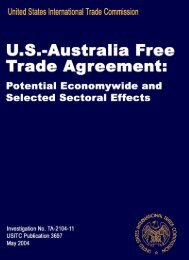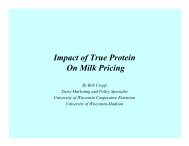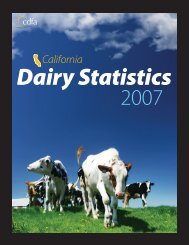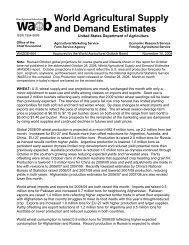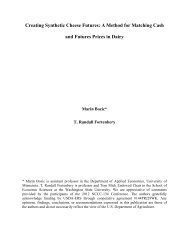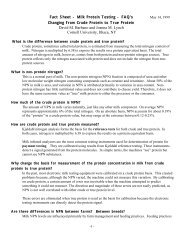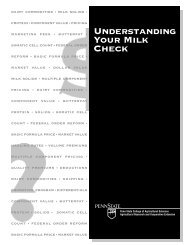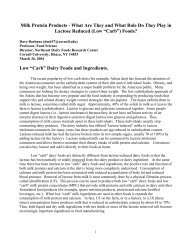Butter - Understanding Dairy Markets
Butter - Understanding Dairy Markets
Butter - Understanding Dairy Markets
Create successful ePaper yourself
Turn your PDF publications into a flip-book with our unique Google optimized e-Paper software.
www.lmic.info<br />
Analysis & Comments<br />
Livestock Marketing Information Center<br />
State Extension Services in Cooperation with USDA<br />
July 1, 2011<br />
Letter #26<br />
BUTTER: Stocks, Production, Trade, and Consumption<br />
Milk can be used for a diverse array of products with a multitude of characteristics. As a result the dairy<br />
complex has a multitude of data, including prices, production, stocks, trade and consumption. All these<br />
pieces are slightly different depending on product but largely have similar relationships when discussing<br />
market forces. The dairy complex has entered what many believe to be a new era of globalization. U.S.<br />
products are increasingly being consumed overseas, and the link between trade and other facets of a<br />
product is critical to the understanding of volatility and market direction. However, not all dairy products<br />
have data provided through public channels for various reasons. <strong>Butter</strong> will be the focus of this article,<br />
based on data availability and heightened interest from export markets.<br />
Production<br />
<strong>Butter</strong> production in the U.S. is highly seasonal with output the highest in the winter months and<br />
decreases in the summer months. On average butter production declines 50% from January to August,<br />
before increasing 36% August to December. The seasonality of butter production is a product of two<br />
items. First, milk production declines in the summer months as does butterfat tests. <strong>Butter</strong>fat yield<br />
follows a similar cycle, although not to the degree production fluctuates. <strong>Butter</strong>fat or milk fat (usually<br />
when referred to the raw product) is the portion of milk made up of fat. <strong>Butter</strong>fat tests are usually the<br />
highest in December and lowest in July, however percentage wise, the decline in butterfat is only 7%<br />
from the highest to the lowest month. Second, summer increases competition for other products that use<br />
butterfat, mainly ice cream. <strong>Butter</strong> essentially takes this fat and removes the liquid through a process<br />
called churning. Other products use milk fat as well, but ice cream probably uses the most in terms of<br />
quantity. Ice cream requires a minimum of 10% butterfat, and has the biggest draw during the summer<br />
months. Ice cream production peaks mid-summer as butter production troughs in late summer. Figure 1<br />
and 2 depict butter and ice cream production seasonality.
Page 2<br />
Figure 1: Seasonal Index for <strong>Butter</strong> Production in the United States. Data Source: USDA-NASS <strong>Dairy</strong><br />
Products Monthly<br />
Index Value<br />
1.4<br />
1.35<br />
1.3<br />
1.25<br />
1.2<br />
1.15<br />
1.1<br />
1.05<br />
1<br />
0.95<br />
0.9<br />
0.85<br />
0.8<br />
0.75<br />
0.7<br />
0.65<br />
Maximum<br />
Average<br />
Minimum<br />
Months<br />
Figure 2: Seasonal Index for Ice Cream Production in the United States. Data Source: USDA-NASS <strong>Dairy</strong><br />
Products Monthly<br />
1.4<br />
Index Value<br />
1.3<br />
1.2<br />
1.1<br />
1<br />
0.9<br />
0.8<br />
0.7<br />
0.6<br />
Average<br />
Maximum<br />
Minimum<br />
Months<br />
Even with a great degree of production fluctuation during the year, butter production has remained<br />
steadily increasing year after year. Graphically, a zig-zag pattern occurs when monthly production is<br />
graphed year after year. Regressing production data against time yields a linear curve gaining 100<br />
thousand pounds of butter produced annually. Figure 3 illustrates both actual and trended production.
LMIC<br />
Page 3<br />
Figure 3: <strong>Butter</strong> Production. Data Source: USDA-NASS <strong>Dairy</strong> Products Monthly<br />
1000s lbs<br />
180000<br />
160000<br />
140000<br />
120000<br />
100000<br />
80000<br />
60000<br />
Actual Production<br />
Trended Production<br />
Cold Storage<br />
40000<br />
Jan‐96<br />
Sep‐96<br />
May‐97<br />
Jan‐98<br />
Sep‐98<br />
May‐99<br />
Jan‐00<br />
Sep‐00<br />
May‐01<br />
Jan‐02<br />
Sep‐02<br />
May‐03<br />
Jan‐04<br />
Sep‐04<br />
May‐05<br />
Jan‐06<br />
Sep‐06<br />
May‐07<br />
Jan‐08<br />
Sep‐08<br />
May‐09<br />
Jan‐10<br />
Sep‐10<br />
Months<br />
Lumpy production indicates there is most likely uneven amounts of inventory unless consumption closely<br />
matches production. Month-end inventory data is provided in a mandatory survey done by USDA-NASS<br />
(National Agricultural Statistics Service) in the Monthly Cold Storage report, which describes frozen<br />
butter that will be generally stored 30 days or more. Unsurprisingly, butter inventories move largely<br />
opposite of production month-to-month. Highest inventories of butter are usually in the summer and are<br />
the lowest in the fourth quarter of the year.<br />
Looking back to cold storage in January 1992, butter inventories were extremely high. In 1992 butter<br />
inventories were nearly 800 million pounds, a result of price supports and production outpacing<br />
disappearance. The price supports declined after 1992 moving butter to a market pricing system. From<br />
1992 to 1996 disappearance caught up with production and eventually helped whittle away stocks to the<br />
lowest they have been to date at 13.7 million pounds. The movement to a market driven price had several<br />
implications: an overall higher average price, greater price volatility and lower stocks in cold storage.<br />
Since then, butter inventories have had a greater control over price. General themes indicate prices<br />
average higher when cold storage is lower. By looking at annual average price and inventory this pattern<br />
is more evident and is shown in Figure 4. Note changes in price are usually a within $0.40 per pound<br />
(33%), while cold storage changes are much greater (sometimes moves greater than double).
Page 4<br />
Figure 4: Annual Price and Cold Storage Levels: 1999-2010. Data Source: USDA-NASS Monthly Cold<br />
Storage<br />
Lbs in Cold Storage<br />
250000<br />
Price per Lb<br />
$2.00<br />
$1.80<br />
200000<br />
$1.60<br />
$1.40<br />
150000<br />
$1.20<br />
$1.00<br />
100000<br />
$0.80<br />
50000<br />
0<br />
Cold Storage<br />
<strong>Butter</strong> Price<br />
1999 2000 2001 2002 2003 2004 2005 2006 2007 2008 2009 2010<br />
Year<br />
$0.60<br />
$0.40<br />
$0.20<br />
$0.00<br />
Trade<br />
Previous to the last five years, exports of butter have relied on subsidies from incentive programs as a<br />
way to clear out inventory levels. As discussed above, cold storage levels were at record levels and to<br />
alleviate some of the burden exports were heavily subsidized to reduce inventory levels. <strong>Butter</strong> exports<br />
from 1980-1994 are subsidized as a result of direct product sales by the government or disbursement<br />
through U.S. aid programs. Heavily aided by these export programs, shipments spiked throughout 1992-<br />
1996, before inventory levels dropped to new lows.<br />
Trade had returned to a more flat stagnant pattern for close to a decade. From 1997 to 2006, butter<br />
exports were uninterrupted and were very low compared to the patterns experienced in the early 1990s.<br />
Since 2006, exports have risen significantly but tumultuously. The volatility in exports makes it difficult<br />
to discuss a normal trend, when as recently as 2009 exports decreased nearer to the level they were at for<br />
the prior decade. Figure 5 shows annualized trade figures from 1991 through 2011 year-to-date.<br />
Imports have also followed cold storage volumes, remaining high in years of low inventory and<br />
decreasing in years of higher inventory. High spikes in imports largely follow high spikes in domestic<br />
prices. Historically, months where domestic price has been above $1.70 per pound imports have risen<br />
drastically. Import influxes seemingly from price increases have occurred in 1998, 2001, 2004, and 2008.<br />
So far, 2010 and 2011 have failed to follow the historic pattern. It is likely this failure is due to the<br />
differential between domestic and world prices, butterfat supply and currency rates during this time<br />
period.
LMIC<br />
Page 5<br />
Figure 5: Annual Imports and Exports of <strong>Butter</strong> (HTS Trade Codes 40510). Data Source: USDA-FAS<br />
using GATS.<br />
1000 lbs<br />
200000<br />
150000<br />
Exports<br />
Imports<br />
100000<br />
50000<br />
*2011 is YTD<br />
0<br />
Year<br />
Domestic Consumption<br />
<strong>Butter</strong> use in the U. S. is also highly seasonal. The peak month for use is in October, while the lowest<br />
month is December. Use is calculated by taking previous month’s cold storage inventory, adding<br />
production and imports and then subtracting exports and cold storage for current month. By calculating<br />
disappearance in this manner, it provides a look at domestic use for a single month. Domestic use year<br />
over year is increasing, however, at a decreasing rate.<br />
Consumption seems to be impacted in general by price but with a time lag. The USDA-NASS weekly<br />
prices in the <strong>Dairy</strong> Product Price report represent commercial prices; inventory purchased is captured by<br />
consumption unless picked up by cold storage or exports. These prices, however, are not capturing the<br />
price the consumers pay and thus by lagging consumption, the relationship between price and<br />
disappearance is more evident.<br />
<strong>Butter</strong> consumption is further complicated by the variety of substitutes and definitions of butter. One of<br />
butter’s biggest competitors is margarine. Data dating back to 1909 compiled by USDA-ERS (Economic<br />
Research Service) shows the strong relationship. Total consumption of both products has been on the rise<br />
since 1909, with little interruption, gaining on average 25 million pounds a year through 1993. Since<br />
1993 total consumption has dropped significantly, falling on average of 85 million pounds a year. Over<br />
the last century butter and margarine have swapped market share twice, most recently in 2005 (See Figure<br />
6).<br />
<strong>Butter</strong> was supreme in use prior to 1958. However, margarine consumption was responsible for the quick<br />
gain in total consumption of both products, surging upwards from 1909 through 1993 also. Margarine<br />
surpassed butter consumption in 1958 and has remained the higher use product until very recently. <strong>Butter</strong><br />
use has been less turbulent, gradually declining since the 1930s through the 1980s. Recently, however,
Page 6<br />
butter has overtaken margarine once again and seems to be gaining ground, despite the overall decline in<br />
the use of both products.<br />
Figure 6: <strong>Butter</strong> versus Margarine Use: 1909-2010. Data Source: USDA-FAS, compiled by USDA-ERS<br />
Mills. Lbs<br />
3,500<br />
3,000<br />
2,500<br />
2,000<br />
1,500<br />
1,000<br />
500<br />
Total <strong>Butter</strong> Use<br />
Total Margarine Use<br />
0<br />
1909<br />
1913<br />
1917<br />
1921<br />
1925<br />
1929<br />
1933<br />
1937<br />
1941<br />
1945<br />
1949<br />
1953<br />
1957<br />
1961<br />
1965<br />
1969<br />
1973<br />
1977<br />
1981<br />
1985<br />
1989<br />
1993<br />
1997<br />
2001<br />
2005<br />
2009<br />
Year<br />
The Role of International Price and Expectations<br />
International prices play a role also in butter inventories, trade and prices. Price data is available through<br />
Oceania and European ports but is provided per fortnight, and is a sample of supplier sales. International<br />
prices have generally been lower than the domestic price, historically. Comparing USDA-NASS <strong>Dairy</strong><br />
Product Prices figures to the international prices reported by USDA-AMS (Agricultural Marketing<br />
Service) in <strong>Dairy</strong> Market News, the earliest data (September 1998 domestic price), has always been much<br />
higher than the converted ($/MT to $/lb) international price until 2007. In 2007 and 2008 international<br />
prices were substantially higher and since 2008 the U.S. domestic price has remained in line with both the<br />
European and Oceania prices.<br />
Price divergence was so great in the previous decades that it is no surprise the U.S. had limited exports<br />
during that time, without the help of government subsidy. However, as of late, butter exports have been<br />
climbing more on their own, but with some assistance from the Cooperatives Working Together’s export<br />
assistance program. With more consistent exports and a greater world marketplace, U.S. markets should<br />
remain more closely in line with international prices, but it is also important to see that international<br />
prices have actually risen to the level higher than the conventional U.S. price range and with it; U.S.<br />
prices have followed them upward past $2 per pound (See Figure 7).
LMIC<br />
Page 7<br />
Figure 7: Weekly International and Domestic Prices: 1998-Current. Data Source: USDA-AMS <strong>Dairy</strong><br />
Market News and USDA-NASS <strong>Dairy</strong> Product Prices.<br />
U.S. $ per Lb<br />
$3.00<br />
$2.50<br />
$2.00<br />
$1.50<br />
$1.00<br />
Europe<br />
$0.50<br />
Oceania<br />
United States<br />
$0.00<br />
9/4/1998<br />
1/4/1999<br />
5/4/1999<br />
9/4/1999<br />
1/4/2000<br />
5/4/2000<br />
9/4/2000<br />
1/4/2001<br />
5/4/2001<br />
9/4/2001<br />
1/4/2002<br />
5/4/2002<br />
9/4/2002<br />
1/4/2003<br />
5/4/2003<br />
9/4/2003<br />
1/4/2004<br />
5/4/2004<br />
9/4/2004<br />
1/4/2005<br />
5/4/2005<br />
9/4/2005<br />
1/4/2006<br />
5/4/2006<br />
9/4/2006<br />
1/4/2007<br />
5/4/2007<br />
9/4/2007<br />
1/4/2008<br />
5/4/2008<br />
9/4/2008<br />
1/4/2009<br />
5/4/2009<br />
9/4/2009<br />
1/4/2010<br />
5/4/2010<br />
9/4/2010<br />
1/4/2011<br />
5/4/2011<br />
Week<br />
Some key drivers will determine if prices both international and domestic will remain at current levels.<br />
World demand for butterfat is probably the biggest factor. In the U.S. volumes have been reduced at<br />
higher butter prices. Year-to-date sale volumes are approximately 80% of last year’s. Figure 6 describes<br />
domestic butter sales volume. In the June, 14, 2011 <strong>Dairy</strong> Product Prices report by USDA-NASS butter<br />
hit $2.14 per pound and volumes dip below the five year average. Lowest volumes occur when butter is<br />
above $2 per pound, which is well above (37%) the weekly five year average price.<br />
Despite high prices, and softening volumes, butter prices are expected to remain above $1.90 per pound<br />
for the remainder of the year. Strength in global demand will continue to support prices both here and<br />
abroad. Exports year-to-date are double what they were in 2010. Low inventory levels also should<br />
support price levels. Prices are high enough manufacturers are unlikely to want to hold more product than<br />
is necessary to meet needs. Finally, domestic demand is also picking up as shown in Figure 5, surpassing<br />
margarine, and feeding off emerging food trends that encourage eating natural food.<br />
Conclusions<br />
The interconnection of cold storage, trade, production and price make it difficult to describe finite<br />
relationships connecting each. In reality it’s the constant moving parts of each that describe the butter<br />
complex as a whole. Peeking into some of the relationships, even if they are generalizations does provide<br />
some understanding to price volatility. Transparency, however, is still something that eludes many<br />
products in the dairy industry because of this interconnection of data, data availability and the timeliness<br />
of some data products.



